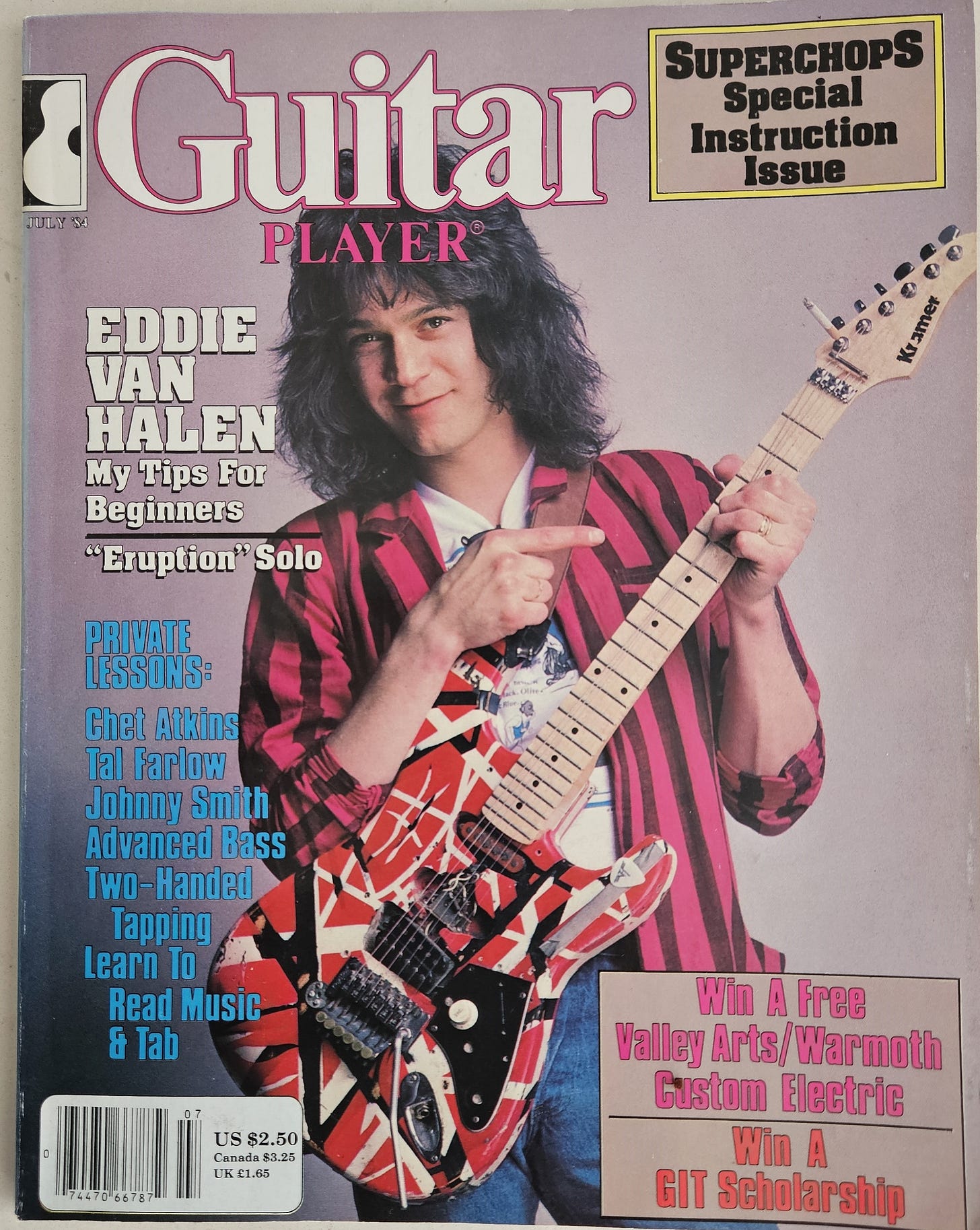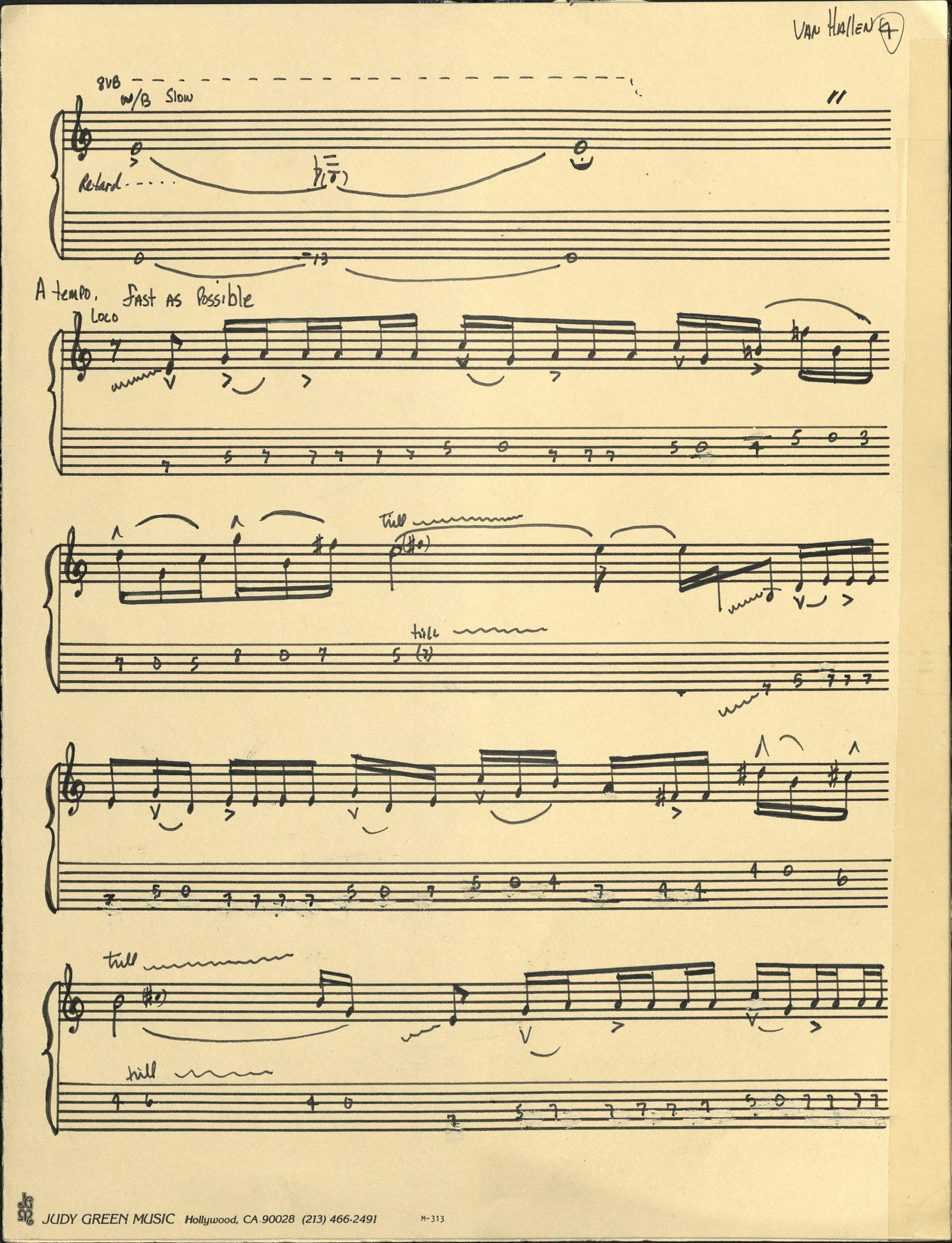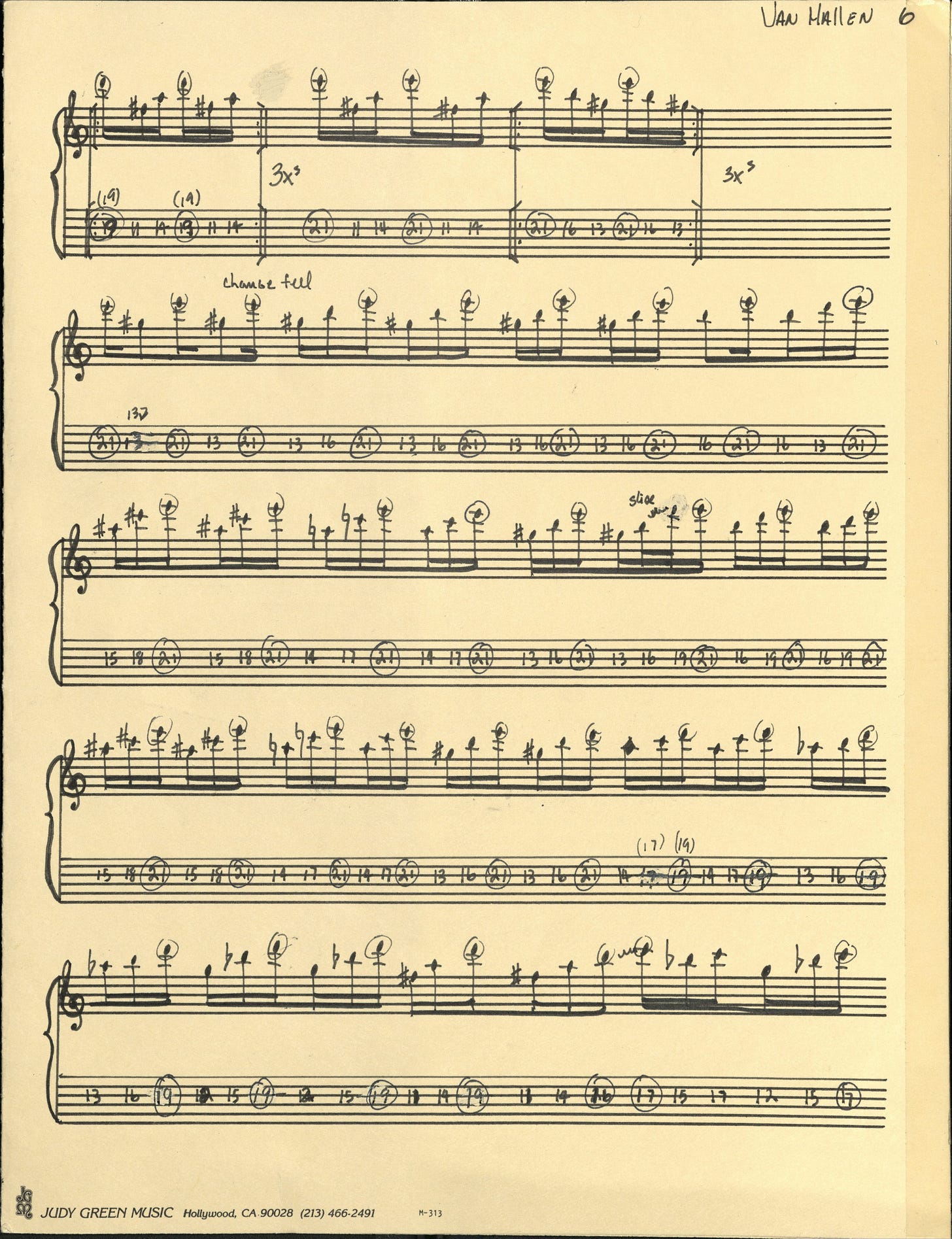Steve Vai’s Handwritten Transcription of Van Halen’s “Eruption”
From 1984: A Scan of Vai’s Original Seven-Page Document
While I was a staff editor at Guitar Player, we decided to feature Eddie Van Halen on the cover of the July 1984 issue. Since I’d already interviewed Eddie four times for the magazine, we asked if he’d be willing to give our readers a crash course in his playing style. Eddie agreed, and our music editor, Jim Ferguson, was dispatched to Los Angeles to meet with him for the “My Tips For Beginners” section of the cover story.
We also thought it would be beneficial to include music for more advanced players. Eddie’s “Eruption,” the guitar-and-drums instrumental on 1978’s Van Halen, seemed the obvious choice. But who could transcribe such a complex piece of music, with its groundbreaking finger taps, whammy wranglings, and sonic effects? The answer: Steve Vai, who’d just finished recording his Flex-Able solo album.
At the time, the 23-year-old Vai had already attended the Berklee College of Music and was a member of Frank Zappa’s band. Zappa regularly referred to the six-foot-tall Vai as “our little Italian virtuoso.” Steve found his way into Zappa’s orbit by doing freelance transcriptions of some of Frank’s more complex pieces. We contacted Steve, and he agreed to take on the “Eruption” assignment.
Soon afterward, Vai’s package arrived. The instant I unfolded his taped-together seven-page transcription, it struck me as a work of art. For starters, it was handwritten on cream-colored music paper. A similarly colored variation of White-Out had been used to make corrections. Notes on the top left-hand corner of the first page declared “Guitar Part Transcribed for Guitar + Pumped Marshalls” and “Balls Out!” This was no ordinary transcription.
Steve included eight paragraphs of notes to accompany the transcription. Here they are:
“Featuring screaming scale passages and rapid-fire two-handed arpeggios, ‘Eruption’ from the LP Van Halen is one of the most virtuosically performed rock instrumentals on record. Whether you decide to learn the entire solo or just skim it for new ideas and licks, be sure to listen carefully to the piece in order to get the feel and other technical aspects that defy notation.
“Transcribing is an art in itself, and it’s a skill you should cultivate if you want to continually add to your musical vocabulary. Most players of improvisational styles—especially jazz, blues, and rock—learned the majority of what they know by taking music off of records. When I transcribe, I transfer the tune from disc to reel-to-reel recorder, which enables me to slow down a solo and double-check each phrase. And I often use a cassette, because it’s easier to operate and facilitates reviewing a lick over and over.
“If you were to compare this transcription to another of the same tune, you would undoubtedly see differences. Even if you were transcribe the same piece two different times, you would likely do it differently. While some transcriptions are far more accurate than others, in general the art is a relative one. (For instance, the pitch of a particular bend might fall between two notes, and consequently be written in more than one way. In other words, when putting a player’s improvisations on paper, the rhythms, notes, and fretboard positions of licks are open to interpretation.)
“When transcribing, I try to get not only the notes, but as many nuances as possible (including mistakes). In order to put a piece on paper more accurately, I notate it with tradition symbols as well as with some unorthodox ones, which I’ll outline in the following paragraphs.
“The letter M means to mute a note slightly with the palm of the right hand, while M with a diagonal line through it indicates a slightly muted note. W/B means to bend a note with the whammy bar; the negative numbers in tab (e.g., -1, -2, etc.) indicate how many frets a note is being bent down. The first place the whammy bar is used is for the -5 in the fifth line of the solo. To play the notation, pluck the open E string and bend it down with the whammy bar, sounding a low B, equivalent to the note five frets lower.
“A diamond-shaped note on the same stem as a regular note designates a harmonic overtone created by sounding a string with the pick (the normal note is the one being fingered) and quickly stopping the vibration with the flesh of the right-hand thumb; some experimentation may be necessary. A circled note means to tap the fretboard with a finger of the right hand. The accent > indicates a note to be slightly accentuated when picked, while the A means to play the note almost staccato (short). And a square note head designates a ghost note—one that can’t be heard very well and that might have been played accidentally.
“For the opening slide, start high on the fifth string (A) with your left hand and slide down; listen to the record. For the chords in line 6, Eddie overdubbed extra notes to add punch. The 5:3 designation in line 9 means to play five notes in the space of three beats.
“Have fun with the solo, and I’ll see you in an upcoming issue.”
The year after the 1984 Van Halen issue came out, Steve began his celebrated stint with David Lee Roth.
Fast forward four decades: In January 2025 I posted a podcast of an interview Steve and I had done just after he’d completed Roth’s Skyscraper album [hear it here: Steve Vai: The David Lee Roth “Skyscraper” Interview]. Given the positive response that came in, I thought fans of Steve Vai and Eddie Van Halen would enjoy seeing the “Eruption” transcription Steve had done before he achieved worldwide fame.
I emailed Steve to ask his permission, and he quickly responded with typical graciousness: “Hey Brother Jas! Of course it’s fine to use it. These days I might question its accuracy, so please give it a good proofreading perhaps…. Many years, many shows, many notes later, and I’m still very appreciative of all the support you gave me in my early years.” Thank you, Steve!
A final note: The 40-year-old original document is housed in the University of North Carolina’s Southern Folklife Collection, where it’s archived in the SFC’s state-of-the-art facility in the Wilson Library. Many thanks to the always-helpful Shaw Lentz of the SFC for creating these hi-res scans. Enjoy!
Related podcasts featuring audio of Steve Vai and Eddie Van Halen:
Steve Vai on Recording David Lee Roth’s “Skyscraper” Album; Eddie Van Halen: “My First Interview”; Eddie Van Halen: The Complete 1979 Interview; Eddie Van Halen: The Complete 1980 Interview - Tape 1; Eddie Van Halen: The Complete 1980 Interview - Tape 2; Eddie Van Halen: The Complete 1980 Interview - Tape 3; Eddie Van Halen: The Complete 1980 Interview - Tape 4; Eddie Van Halen Plays, Sings, and Hums Unreleased Van Halen Songs (Tape 5; Eddie Van Halen and Sammy Hagar: The 1987 Interview, Part 1; Eddie Van Halen and Sammy Hagar: The 1987 Interview, Part 2; Van Halen’s Michael Anthony: The Complete 1981 Interview .
A special thanks to my paid subscribers, whose support enables me to continue producing the Talking Guitar magazine and YouTube channel. For $5 a month (or $40 a year), paid subscribers have complete access to the hundreds of articles, interviews, and podcasts posted in Talking Guitar.
©2025 Jas Obrecht. All right reserved.











This is an amazing find and it goes a long way showing Steve Vai's musical skills (plus being a super nice guy to boot) , I'm not into his music but that doesn't mean he is not a master musician who takes his craft very seriously, thank you for this post.
Has Steve ever revisited his transcription to update or discover things that he would change in his tab/notation?